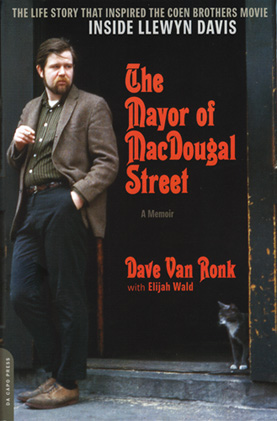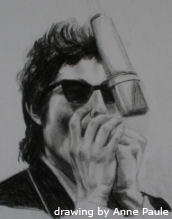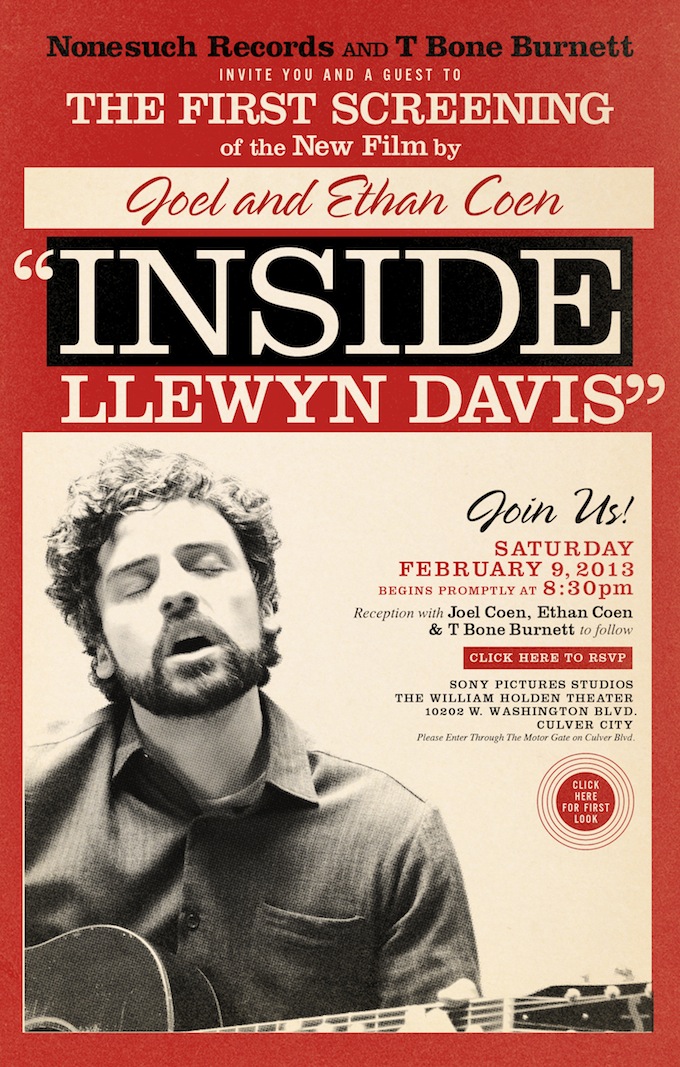“The Mayor of MacDougal Street” and “Inside Llewyn Davis”: A Critical Comparison and Analysis.
 A lot has been said about the accuracy and intent of bringing this mostly historical novel to the screen and whether the Coen Brothers did it justice. There was so much pre-release hype beginning with the first screening in February 2013 (pre-Grammy push) until its ultimate release in December of 2013 (pre-Oscar push) that nobody who wasn’t an industry insider knew what to think. The more the Brothers talked and advertised a movie you could not see as well as promoting a September concert celebrating the movie’s release you could not get tickets to, the bigger a hole they dug for the movie. Glib, throw away interview comments like “It’s about a cat and cats are hard to direct” to “The audition process was so painful” were simply hard to listen to. Since when is being a successful filmmaker doing what you love a painful process? All that was being said in the press was how bad it was and how they were guilty of crimes against the folk movement for not using the book, at all. So after seeing the movie you have to ask yourself one question. Was it good enough for you? The answer for me was: You’re damn right it was and they should do it again.
A lot has been said about the accuracy and intent of bringing this mostly historical novel to the screen and whether the Coen Brothers did it justice. There was so much pre-release hype beginning with the first screening in February 2013 (pre-Grammy push) until its ultimate release in December of 2013 (pre-Oscar push) that nobody who wasn’t an industry insider knew what to think. The more the Brothers talked and advertised a movie you could not see as well as promoting a September concert celebrating the movie’s release you could not get tickets to, the bigger a hole they dug for the movie. Glib, throw away interview comments like “It’s about a cat and cats are hard to direct” to “The audition process was so painful” were simply hard to listen to. Since when is being a successful filmmaker doing what you love a painful process? All that was being said in the press was how bad it was and how they were guilty of crimes against the folk movement for not using the book, at all. So after seeing the movie you have to ask yourself one question. Was it good enough for you? The answer for me was: You’re damn right it was and they should do it again.
The book, The Mayor of MacDougal Street, is a must-read for folk fans. It is the most accurate history of the post-Weavers folk scene out there. It can be used as a text book for the period leading up to the folk explosion of the early 60’s. What is most amazing about the book is that it indeed crowns Dylan as the worthy king of all things folk once he got the deal with Columbia Records after maybe five solo gigs at the coffeehouses while also detailing the inner conniving and stealing Bob did all under the cover of his awkwardness and dead-fish handshake. “So sorry I stole your version of [this or that] folk song.” The problem with folk is that most of the songs are not owned but arranged by the entertainer with no copyright protection for the arranger. Bob was able to use other people’s versions of public domain material without compensating them for their years of hard work creating a particular version of an old staple. Bob also wrote a ton of original material derived from these versions and became filthy rich without looking back to see whose toes he stepped on. But that’s not nearly the whole of the book. The story is about the musical journey and private life of Dave Van Ronk. It is a very satisfying read and takes you on a joyride back to the Greenwich Village Folk Scene and explains from where it got its roots. All the musicians that previously lack attribution get ample credit here and the accuracy is first person assured. The forward by Lawrence Block is a nice touch and Elijah Wald the co-writer makes it prose.
There were so many people and styles to write about on the way to “The Great Folk Scare of 1961” as Dave called it, to blame anything on Dylan. He made it and made it big. That gave a lot of people their career moment because of all the attention the scene got but it also made a lot of people angry who had worked so hard for more than just a momentary payoff of four or five years. It took so many years for the scene to break that the book gives you the feeling it never will. It begins to appear that all the musicians Dave hung out with in Washington Square Park and played with in the coffeehouses would die penniless for their art and be possibly blacklisted for their beliefs they espoused either in the music or at political meetings and rallies. How romantic it was to be a true folk artist hanging at the Folklore Center before the flood of tourists who came to see beatniks and got folkies in a gawking two-fer-one. One funny anecdote is that originally they’d hire Dylan to clear the house for the next Beatnik poet with his hard to handle voice and offbeat stage demeanor which later became valuable bankable trademarks.
After the “Scare” was over there wasn’t as much money for “folk” artists which is, you’ll find out in the book, a misnomer because they were really the new generation of singer-songwriters. Folk after all is the taking of traditional songs and pushing them forward by continuing to pass them down generation to generation, from one particular culture or another, carrying their values and habits along with the familiar tune each artist changing little aspects along the way. So what if many of Dylan’s songs are simply re-worked folk classics? He was the most prolific and entertaining weirdo around and made the most of it with his creepy controlling manager always there to facilitate it. Dave exposes the names of the close circle of friends that surrounded Bob and protected him from anybody who would doubt the king or speak ill of him. Of course those friends were fungible commodities too. Dave didn’t care about all that because he took care of Dylan when he first came to NYC and Bob was first managed by Dave’s wife. They were close and it’s very interesting and you haven’t heard it before because it’s all very ugly too. It was the typical industry backstabbing and double dealing that always goes on and it still doesn’t scratch the surface of what you’ll learn reading Dave’s book. Music is about finding it, uncovering it, developing it and then finally making it. Dylan did his homework and had the mystique to go with it.
 Now for the movie Inside Llewyn Davis and whether it is an honest interpretation of the book the Coen’s bought the rights to. The Brothers would tell you like, the Syd Field screenwriting books do, that every movie has three acts. OK, they went to NYU Film School where Scorsese went but it’s all the same crap. Towards the end of act one there will be a plot point which turns the action in a different direction and then in the third act the same thing for plot point two. The purpose of which is to keep the viewer in suspense for the ultimate payoff at the end because otherwise we’d be bored. It’s a unique voyeuristic experience watching someone’s compressed life unfolding in front of us within the narrow context of sitting and watching the film for two-plus hours. Keeping the viewer engaged is essential. The movie’s two plot points are directly, (let me emphasize this) DIRECTLY taken from the book.
Now for the movie Inside Llewyn Davis and whether it is an honest interpretation of the book the Coen’s bought the rights to. The Brothers would tell you like, the Syd Field screenwriting books do, that every movie has three acts. OK, they went to NYU Film School where Scorsese went but it’s all the same crap. Towards the end of act one there will be a plot point which turns the action in a different direction and then in the third act the same thing for plot point two. The purpose of which is to keep the viewer in suspense for the ultimate payoff at the end because otherwise we’d be bored. It’s a unique voyeuristic experience watching someone’s compressed life unfolding in front of us within the narrow context of sitting and watching the film for two-plus hours. Keeping the viewer engaged is essential. The movie’s two plot points are directly, (let me emphasize this) DIRECTLY taken from the book.
I won’t spoil it for you because you’d just be bored knowing they’re coming. But they are there. Read the book first then see the movie. I believe almost none of the writers who said the movie didn’t do the book justice even bothered to read the book. Granted the film is not about Dave Van Ronk per se but the fictional character they created goes through more or less all the main story lines developed in the book. Of course it leaves out a lot of the history of the folk movement but it’s a MOVIE. If you want to see the “The Great Folk Scare of 1961” or the Dave Van Ronk Story maybe get Ken Burns on the case. This film is an intimate and absolutely wonderful look at a small slice of NYC life in the early sixties as recounted by Dave Van Ronk. Oscar Isaac is a pleasure to watch and his musicianship is up to the task.
The film’s soundtrack by T. Bone Burnett on Nonesuch Records is a first in a non-musical drama. They have the artists play the entire song through in real time. Nice touch. Justin Timberlake’s plays Llewyn’s former folk duo partner and is very entertaining as the nerd folkie. John Goodman (well here’s a spoiler) plays the heck out of a fictitious Jazz legend OD’ing on the floor of a roadside bathroom on the way to a gig. He’s a well-drawn bookend to Oscar’s made-up folk recording artist who can’t quite get there while his closest friends and allies either make it big or fold the tent to go back to their comfortable destinies with wives, children and secure jobs. Llewyn’s story just happens to be Dave’s exact story because in the end they both don’t have another job to go to so if you read the book you know that the artist goes on to be a folk artist. He’s not famous but not a boring dentist in the suburb’s either. The character in the movie does become The Mayor of MacDougal Street. The filmmakers do have the right to change things around enough to make the film move fast and keep our attention and these guys took the new character and imbued him with Dave’s gravitas.
 Oh and the cat plot? Well the cat is a great actor indeed they cast it well or is it two different cats? For all you doubters about the authenticity of the cat well, it’s right there on the cover of Dave’s book and album: Inside Dave Van Ronk put out on Folkways Records. This story line about Llewyn’s record label is right from the book complete with label head and famous cheapie Moe Asch played like a fiddle by Jerry Grayson in his final film role. Also, in the book and the movie is Chicago’s premier folk club The Horn of Plenty complete with owner Albert Grossman, Dylan’s future manager. That scene with Albert played perfectly by actor’s actor powerhouse F. Murray Abraham has the most devilish silences I’ve ever not heard. No, it’s not a movie about a cat. Joel and Ethan may be a full of themselves but they created a Blood Simple type indie film years after they became mega box office giants. So yes, they did the book justice. All the important events that happen to Dave during his life are there on the screen just played by a different fictitious character. The folk fans deserved more in terms of waiting so long for it to finally come out and being allowed to participate in the release hoopla. Forgetting all the unnecessary awards posturing and self-congratulation nonsense the movie was as advertised.
Oh and the cat plot? Well the cat is a great actor indeed they cast it well or is it two different cats? For all you doubters about the authenticity of the cat well, it’s right there on the cover of Dave’s book and album: Inside Dave Van Ronk put out on Folkways Records. This story line about Llewyn’s record label is right from the book complete with label head and famous cheapie Moe Asch played like a fiddle by Jerry Grayson in his final film role. Also, in the book and the movie is Chicago’s premier folk club The Horn of Plenty complete with owner Albert Grossman, Dylan’s future manager. That scene with Albert played perfectly by actor’s actor powerhouse F. Murray Abraham has the most devilish silences I’ve ever not heard. No, it’s not a movie about a cat. Joel and Ethan may be a full of themselves but they created a Blood Simple type indie film years after they became mega box office giants. So yes, they did the book justice. All the important events that happen to Dave during his life are there on the screen just played by a different fictitious character. The folk fans deserved more in terms of waiting so long for it to finally come out and being allowed to participate in the release hoopla. Forgetting all the unnecessary awards posturing and self-congratulation nonsense the movie was as advertised.
Here’s another tidbit from the book that didn’t make it into the movie. Dave was the first to record and release “Both Sides Now” by a somewhat unknown Joni Mitchell and even though he got it out first and was given the right to do so by Joni which is almost unheard of today. Judy Collins killed it’s momentum on the radio by releasing her own version which became one of the biggest folk hits ever. This is the way the copyright law works: once a song is released anybody can re-record it and pay a set fee to the writer so nobody screwed anybody that time unlike Bob’s manipulations early in his career. It was just simply that the best version of a great song won and Dave eventually came in third although he had a nice head start given that Joni’s version is also very popular. Dave continued on undeterred to be an almost always broke but successful folk musician the rest of his life. His ultimate dream was realized as he got to be a professional musician his entire life. Isn’t that a feel good ending? The moral of the story is don’t be a musician unless you can’t do anything else.
Of course it would be nice to see this story told again with him as the main character not a twisted around version of him sleeping on couches instead of being the one who provided the couch that new folk singers like Dylan and others slept on. The artistic license rule was invoked. They do use Dave Van Ronk’s version of "Green, Green Rocky Road" by Len Chandler & Robert Kaufman over the end credits lending a realism I didn’t expect and a real payoff for staying with it until the last credit rolled.
Conclusion: The public doesn’t know what it wants but it knows whether they like what they get so my advice is next time get the damn thing out and have enough concert dates for us folk fans to be a part of it all. You guys shut us out and I had to watch it on demand. If this article came out in time for the Oscars maybe Oscar would have gotten one.
-Steve Gabe, Writer/Editor

